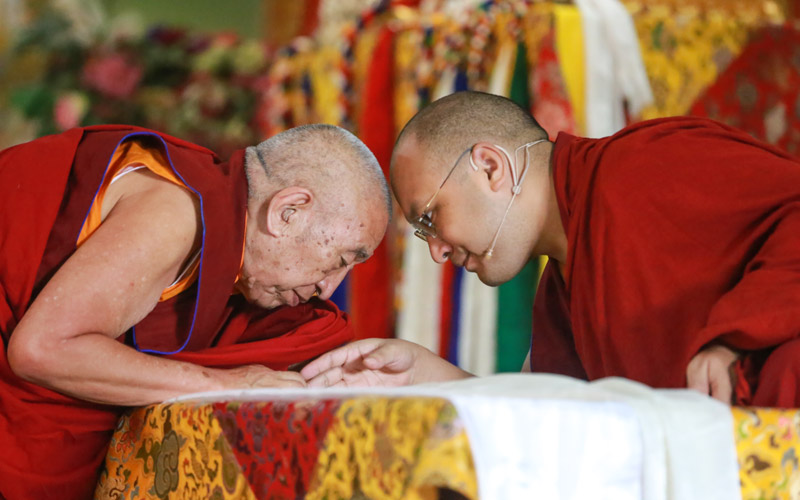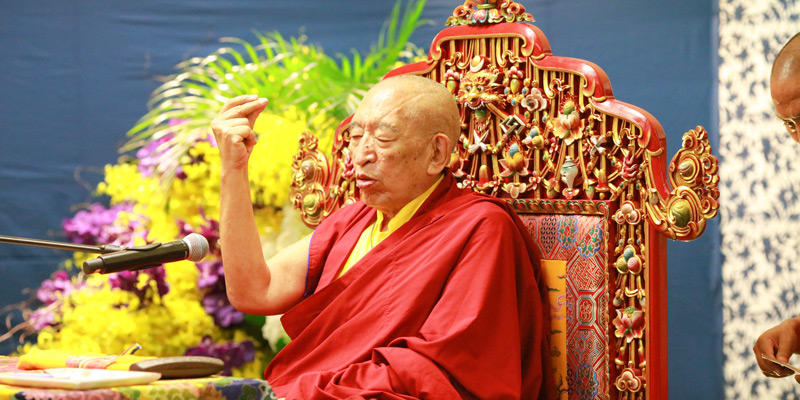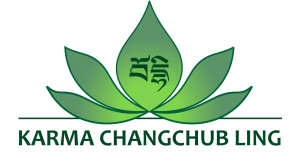The Venerable Khenchen Thrangu Rinpoche was born in the small village of Ralungda in Kham, eastern Tibet in 1933. At the age of five, he was recognized as the Thrangu Tulku by the Sixteenth Gyalwang Karmapa Rangjung Rigpe Dorje and the 11th Tai Situ Rinpoche Pema Wangchuk Gyalpo and enthroned at Thrangu Monastery by Traleg Kyabgön Rinpoche.

Venerable Khenchen Thrangu Rinpoche greets His Holiness 17th Karmapa Ogyen Trinley Dorje
At the age of seven, he began his studies of reading, writing, and ritual and also received empowerments, transmissions, and teachings from visiting lamas including the Gyalwang Karmapa, the Second Jamgön Kongtrul Rinpoche, and Terton Rolpay Dorje. In 1943, he traveled on pilgrimage to visit the sacred sites of Central Tibet and see the Gyalwang Karmapa, who gave him the empowerment of White Tara and had him do a one-month White Tara retreat at Tsurphu Monastery. After returning to Thrangu Monastery, he continued his studies for a year and then spent from 1945 to 1947 in retreat, doing the preliminary practices and certain other important practices.
In 1948, he began his studies of Buddhist philosophy. The Shechen Kongtrul Pema Drimey gave him the transmission of the collected works of Ju Mipham as well as the transmission and explanation of the Treasury of Knowledge. For the next five years, he studied the Way of the Bodhisattva, the Five Great Texts of Buddhist philosophy, and the Dharmas of Maitreya with Khenchen Lodrö Rabsel. Rinpoche was diligent in his studies, studying during meals and by the light of a stick of incense at night.
In 1953, Traleg Kyabgön Rinpoche, the main lama of Thrangu Monastery, suddenly passed away, and then the Second Jamgön Kongtrul Rinpoche, who had come to officiate over the cremation of Traleg Kyabgön, also passed away at Thrangu Monastery. Rinpoche thus became responsible for overseeing Thrangu Monastery and spent the next few years performing these duties. In 1954, he went to see the Gyalwang Karmapa at Palpung Monastery and received full monastic ordination, the bodhichitta vows of the two traditions, and the tantric vows of the empowerments of Tukdrup Barchen Kunsel and Jinasagara (Red Chenrezig). In 1957, Khenpo Gangshar Wangpo visited Thrangu Monastery and gave him mind instructions of dzogchen and mahamudra.
In 1958, Rinpoche and a group from Thrangu Monastery fled advancing Chinese armies and made their way to Central Tibet, where Rinpoche saw the Gyalwang Karmapa, who left for India soon afterwards. Rinpoche followed by a different route in early 1959, traveling through Bhutan to India. Not long thereafter, the Gyalwang Karmapa arranged for Rinpoche to join him at Rumtek Monastery in Sikkim.
From 1960 onward, he spent several years serving the Karmapa at Sikkim, assisting in the construction of the new Rumtek monastery and teaching young monks philosophy. Rinpoche also received many empowerments, transmissions, and teachings from the Gyalwang Karmapa during this period. In 1967, he traveled to Bhaksa in Assam where he took the examinations for the Geshe degree in front of His Holiness the Dalai Lama. He was awarded the highest degree, Geshe Lharampa, and when he returned to Rumtek, the Gyalwang Karmapa granted him the title of Khenchen, or Great Abbot, of the Karma Kamtsang. Rinpoche remained at Rumtek for several more years, teaching the Four Heart Sons and other monks philosophy. When the Seventeenth Gyalwang Karmapa arrived in India in 2000, the Dalai Lama appointed Rinpoche to be his tutor, and Rinpoche several months over a few years in Dharamsala teaching him abhidharma and other subjects. In this way, Rinpoche has played a critical role in preserving the Karma Kagyu lineage of teachings at a time when it was in danger of disappearing due to the Cultural Revolution.
On a pilgrimage to Nepal in 1974, the Sixteenth Karmapa had suggested to Rinpoche that he should build a monastery in Namo Buddha, Nepal. In 1976, Rinpoche came to Nepal and began construction of a three-year retreat center in Namo Buddha and a small monastery near the Great Stupa of Boudhanath. Eventually, the monastery in Boudhanath would be enlarged, and a monastic college, school for young monks, and large new temple—the Thrangu Tashi Yangtse Monastery—were built at Namo Buddha. Rinpoche also established the Thrangu Tara Abbey for nuns near Swayambhunath in Nepal; the Vajra Vidya Institute monastic college in Sarnath, India; the Sekhar Retreat Center in Bhaktapur; and the Nar Satek Retreat Center in Manang. He has also helped rebuild Thrangu Monastery in Qinghai twice, once after the Cultural Revolution and also following the 2010 earthquake. Rinpoche’s monastic sangha has now grown to include nearly a thousand monks and nuns, all of whom are being given equal opportunities for monastic and secular education as well as retreat.

The Very Venerable Ninth Khenchen Thrangu Rinpoche
Rinpoche has also worked on the behalf of the communities surrounding his monasteries and nunneries. He established the Shree Mangal Dveep School in Boudhanath to provide Himalayan children an education. He has also established the Phende clinic in Namo Buddha as well as smaller clinics at Thrangu Tara Abbey and the Vajra Vidya Institute to provide basic medical care for the local communities as well as the sangha.
Even as he has been busy developing the monasteries and sangha in Asia, Rinpoche has traveled the world teaching students from all nations and cultures. For many years, Rinpoche spent several months each year traveling, teaching, and giving empowerments in Asia, Europe, and North America. At his students request, he has founded dharma centers and study groups in Canada, England, Germany, Hong Kong, Malaysia, Taiwan, and the United States. He founded the Thrangu Monastery Canada near Vancouver, Canada, and the Vajra Vidya Retreat Center in Crestone, Colorado, USA, and a monastery construction project is underway in Petaling Jaya, Malaysia. Until the coronavirus epidemic, Rinpoche also gave annual seminars for foreigners in Namo Buddha and at the Vajra Vidya Institute in Sarnath. Rinpoche has thousands of devoted students all over the world.
Thrangu Rinpoche is also a prolific author. He has compiled commentaries on the great texts of the Buddhist philosophical tradition aimed for beginning students. He has written biographies of the Karmapas and other masters of the Karma Kagyu lineage as well as numerous shorter texts on sutra, tantra, monastic conduct, meditation instructions, prayers, supplications, histories, and so forth. In addition, his devoted international students have transcribed many of his oral teachings and published them as books, articles, and pamphlets in English, Chinese, and other languages.
Rinpoche has also taken a great interest in publication and translation of Buddhist texts: under his direction, the Vajra Vidya Library in Sarnath has published many rare texts in affordable editions for students, and in 2002, he founded Thrangu Dharmakara to promote the publication of his teachings and translation into English and Chinese.
Since the beginning of the coronavirus epidemic in March 2020, Rinpoche has been in retreat, first in Sarnath and then at Namo Buddha. He is currently giving the transmission of his collected works in Tibetan over the internet to his monastic sangha and devoted students worldwide.
